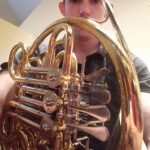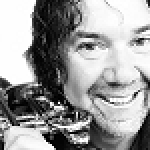WindWorks Trumpet Academy › Forums › WindWorks › angle of the visualizer
Tagged: embouchure, placement, tissue exercise, visualizer
- This topic has 16 replies, 6 voices, and was last updated 2 years, 6 months ago by
wouter.
-
AuthorPosts
-
-
28 August 2021 at 1:32 am #96001
wouter
ParticipantHi Greg,
In regards to your latest video: https://mysterytomastery.com/important-windworks-updates/
I have a question. I can place the visualizer on my lips in with 2 angles1. ‘parallel’ to my lips. As I have an underbite, this means the airstream is pointed downwards. If i point my trumpet downwards also, the airstream is still going straight into the trumpet. However the tissue exercise does not work as I am ‘shooting’ the bottom part of the tissue.
or
2. with a little bit more pressure on my top lip and a little more ‘space’ between the visualiser and the bottom lip. In this way the air comes out straight and the tissue excersize works, but I am affraid this will bring down my endurance as the ‘pressure’ (not a lot) is not equally divided between top and bottom lips.
What is your advise?
Wouter
-
28 August 2021 at 5:15 pm #96075
wouter
ParticipantPS. version 1 gives me better results in playing (especially if I keep the ‘milkcan’ in mind), but I am a little concerned that I may also have to move my jaw slightly forward and that I can not do for a long time
-
31 August 2021 at 7:32 am #96490
 xandar121Participant
xandar121ParticipantHi. I have underbite and with the visualiser and I am also shooting very bottom part of the tissue if any.
The answer to your question is from you :
<< PS. version 1 gives me better results in playing >>
DO what sounds good. Don’t think too much, don’t ovwerthink. It’s hard . I know it. -
31 August 2021 at 8:22 am #96494
johnelwood
ParticipantI think the tissue visualization is a helpful exercise, but stopped doing it after a while.
But even now, I sometimes catch myself moving too much rather than keeping things simple and straightforward and have to get myself back into the right mindset. A little Clarke 1 and 2 on passive air at a soft volume usually helps me a lot.
I would add to Xandar’s recommendation that do what sounds good AND what’s most efficient–these are really the same thing, once you find optimal.
Harmonic slurs, for example, used to be something I powered through like it was an endurance exercise, which it is helpful for endurance; but to really get the full benefit, in my opinion, one has to experiment looking for the easiest way to change pitch as that’s the most efficient AND happens to sound the best as well, which ultimately what playing is about–if we can find the easiest way to produce a given pitch, we’ll have more control, endurance, flexibility, ease of articulation, etc. If it takes everything we have just to touch the pitch, then we’re going to be very, very limited.
Learning to cooperate with the air, not fight the air, is the key.
That’s my perspective, FWIW.
-
31 August 2021 at 5:08 pm #96559
wouter
ParticipantThanks for sharing your answers. I am going to experiment a bit. The best sound is one thing, but efficiency is also important indeed (eventually leading to a better sound also).
-
6 September 2021 at 11:26 am #97327
 Greg SpenceKeymaster
Greg SpenceKeymasterHey guys. I too have an overbite. Without seeing exactly what is going on it is difficult to say.
In order to get vertical alignment at the aperture, I had to bring the jaw forward SLIGHTLY (No TMJ issues when done correctly!). Did it feel weird? Yes! Did it take time to get used to? Yes! Did it sound good at the start? NO WAY!
Don’t be afraid of the difference in sensation, that is the key to fast and effective learning. (See ITG Presentation Part 1 for more on this with Andrew Huberman).
I am yet to meet anyone, no matter how extreme the overbite, who cannot replicate what I am demonstrating.
As you play, there may be changes in angle and this is where the SENSATION DEVELOPMENT comes into play.
REMEMBER: We are creating a new understanding and new feelings – a new psychology and new sensations. When you begin playing, do you experience the same freedom or do you begin to lock up with back pressure?
I’ll do a further video on this important topic.
Cheers,
Greg -
23 September 2021 at 10:40 pm #100458
gary
ParticipantHi all, this post is particularly relevant to me. I’m a comeback player, currently up to Andante Status Stage. I have an overbite and when I do the tissue exercise I have to consciously move my bottom jaw forward slightly to get the best result with the tissue. If I don’t move my jaw forward, the tissue moves up but nowhere near as much. When playing (especially higher notes) I find that more of my bottom lip has a tendency to find its way into the mouthpiece and whilst this seems to help me hit higher notes I’m also aware that this could be the resurgence of bottom lip clamping!
I would appreciate any comments or suggestions to make sure I stay on track. Thanks.
-
25 September 2021 at 9:42 am #100658
johnelwood
ParticipantMore bottom lip in the mouthpiece isn’t necessarily a problem as you go higher. I’ve been having that sensation a bit lately while doing some pretty effortless-feeling harmonic slurs above the staff. The aperture has to be reduced as we go higher and the lips should contract towards the center of the mouthpiece /air column (my understanding…). As long as you’re not rolling the bottom lip under the top lip or engaging the lip muscles too much / clamping, then your bottom lip moving in might not be a bad thing. If it feels and sounds resonant and efficient, it could be ok. My $.02 FWIW, correct me if I’m wrong. Good luck!
-
-
23 September 2021 at 10:41 pm #100459
gary
ParticipantSorry, forgot to ask – Greg, what does ‘TMJ issues’ stand for?
-
23 September 2021 at 10:45 pm #100460
wouter
ParticipantHi Gary,
Happy to hear that I am not the only one struggeling. I can move my jaw forward but even a slight forward change gives me trouble with my joints. So my strategy for now is:
– I try to keep my jaw as relaxed as possible and as much possible ‘in’ the joint (so not forward)
– I roll out my bottom lip slightly AND support it with my tongue anchored on it (this is actually what I have found useful from the TCE trumpet school, but it is not easy to do and you need some time to be able to play with your tongue forward.) This forms a bit of a cussion where i do not need to use the jaw so much and then I can rest my top lip on my bottom lip (alignment) and blow upward a littleit is stil in experimental phase though so my final stand on this i can not give you yet.
Good luck. W.
-
24 September 2021 at 12:02 am #100472
 Greg SpenceKeymaster
Greg SpenceKeymasterHey guys. TMJ is TemporoMandibular Joint Disorder which is a condition that can develop in the jaw if it is pushed too far forward. Add arm pressure the trumpet and you have big issues.
The visualiser exercise will not cause this and I must stress, this is simply a mouthpiece placement drill for the lower register range and to set you up for the Singing C Series.
Once you have successfully placed your mouthpiece and you discover your Sympathetic Oscillation, you are then on your way and you use the purity of tone and sensation of the open and resonant Body’s Concert Hall to determine if things are proceeding efficiently.
Feel free to post or send me a video.
Cheers,
Greg -
24 September 2021 at 6:06 am #100518
gary
ParticipantThanks Wooter, I’ll give it a try.
Thanks Greg, that explains TMJ. (I still can’t stop my bottom lip folding under on higher notes though?)
Gary.
-
27 September 2021 at 6:48 pm #101046
gary
ParticipantThanks johnelwood, I’ll keep persevering.
-
9 January 2022 at 11:25 pm #117446
eggsaseggs
ParticipantAs Greg often says… I’m not really inventing anything new, just presenting it now with science behind it”. I’m a comeback player with pedagogy from the ‘70’s. In Roger Sherman’s book The Trumpeter’s Handbook he stresses aligning the upper and lower teeth which for an overbite means moving the lower jaw forward. Feels weird as you start to ascend in range (airstream will still hit the tissue) but that’s the Process!
-
10 January 2022 at 2:58 am #117469
wouter
ParticipantHi Eggsaseggs,
I would be very careful with moving the jaw forward, it is pretty bad for you chewing joints. Also if you ‘fixate’ the jaw while playing (as do many players do) it will introduce tension in your breathing and playing also (look at classical singers they relax their jaws completely and I was told by a Opera Singing teacher that straining the jaw does kill your ‘resonance’ in singing, thus also in trumpet playing. Trumpet players with an underbite have an advantage though. Anyhow, if you want to bring your jaw forward do it as minimal as possible. I ‘solved’ this allignment issue by touching the bottom lip with my tongue while (trying to) keep the jaw as relaxed and backward as possible. You can also firm up the bottom lip by applying the ‘monkeyface’ embouchure i guess.
Best, Wouter
-
10 January 2022 at 3:38 am #117482
eggsaseggs
ParticipantThanks Wouter. I was just replying to Greg’s comment that HE moved his jaw forward slightly. Of course one must always be concerned with tension anywhere in the body.
-
10 January 2022 at 3:52 am #117485
wouter
ParticipantHi eggsaseggs,
That’s true! 🙂
Best, Wouter
-
-
AuthorPosts
- You must be logged in to reply to this topic.
Recent topics
-
Question of Curiosity – To Teeth or Not To Teeth
by
clawsonk123
1 month, 3 weeks ago -
1.O / 2.0 routine
by
jice.gif
2 months, 3 weeks ago -
Abdominal surgery and time off the trumpet
by
DQ
9 months, 3 weeks ago -
Allegro or Presto Practice Routine
by
djm297
10 months, 2 weeks ago -
Tongue lock – Throat lock
by
Ivo Carrabs
11 months, 1 week ago
